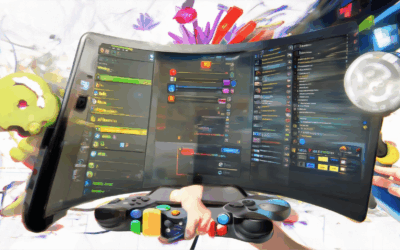Creating a well-balanced game is crucial for delivering an engaging and competitive experience that keeps players invested in the journey. However, striking the perfect balance between challenge and accessibility can be a daunting task, especially for developers who want to prevent exploitation and ensure fair competition among players. By examining game balancing examples from popular video games, we can gain valuable insights into the key factors involved in effective game balancing and the essential elements that contribute to creating a stable and enjoyable gaming ecosystem.

Mastering Game Balancing Examples for Engaging and Competitive Gameplay Experiences
I’m excited to share my expertise on how developers use game balancing examples to create immersive and competitive gameplay experiences.
- The Importance of Game Balancing Examples
- Key Principles of Game Balancing Examples
- Player Agency
- Difficulty Curve
- Replayability
- Feedback Mechanisms
- Real-World Applications of Game Balancing Examples
- Minecraft
- Overwatch
- Dark Souls
- Best Practices for Implementing Game Balancing Examples
- Conduct Thorough Playtesting
- Analyze Player Behavior
- Foster Community Engagement
Game balancing examples are crucial in creating engaging and competitive gameplay experiences. By understanding the intricacies of game mechanics, developers can craft experiences that challenge players and keep them hooked.
When it comes to game balancing examples, there are several key principles to consider:
Players should feel empowered to make choices that impact the game world. This can be achieved through various mechanics, such as character customization, skill trees, and branching storylines.
A well-designed difficulty curve keeps players engaged and challenged. Developers can use various techniques, such as gradual increases in enemy strength or environmental hazards, to create a sense of progression.
Replayability is essential for games that aim to retain players long-term. Developers can incorporate features like procedurally generated levels, random item drops, or multiplayer modes to encourage replay.
Clear feedback mechanisms help players understand the consequences of their actions. This can be achieved through visual cues, sound effects, or UI elements that provide insight into player progress.
Several popular games have successfully implemented game balancing examples to create engaging and competitive gameplay experiences:
Minecraft’s procedurally generated worlds and vast array of items and blocks offer endless possibilities for exploration and creativity.
Overwatch’s diverse cast of heroes, each with unique abilities and playstyles, encourages teamwork and strategy among players.
Dark Souls’ challenging difficulty curve and interconnected world design require players to adapt and learn from their mistakes.
To effectively implement game balancing examples, developers should:
Playtesting helps identify areas where the game may be too easy or too hard, allowing developers to make adjustments accordingly.
Analyzing player behavior provides valuable insights into what works and what doesn’t, enabling developers to refine their game balancing examples.
Engaging with the community helps developers understand player preferences and concerns, allowing them to make informed decisions about game balancing examples.
By incorporating these best practices and key principles, developers can create game balancing examples that result in engaging and competitive gameplay experiences.
Game Balancing Examples Used in Popular Video Games
To prevent exploitation and ensure fair competition among players, game developers employ various game balancing techniques.
-
Example 1: Dynamic Difficulty Adjustment
In games like Destiny 2, the dynamic difficulty adjustment feature ensures that the game adjusts its difficulty level based on the player’s performance, making the game more challenging or easier depending on the player’s skill level.
-
Example 2: Item Balance
Games like World of Warcraft have a team dedicated to item balance, which involves adjusting the stats and effects of items to prevent overpowered gear from dominating the game.
-
Example 3: Player Behavior Analysis
Developers like Blizzard Entertainment analyze player behavior to identify exploits and imbalances in the game, allowing them to make adjustments to prevent cheating and ensure fair play.
-
Example 4: Community Feedback
Many games, such as Overwatch, rely heavily on community feedback to identify issues and make necessary changes to balance the game.
-
Example 5: Regular Updates
Games like Fortnite receive regular updates that include balance changes, bug fixes, and new features to keep the game fresh and exciting for players.
-
Example 6: Competitive Play Modes
Games like League of Legends offer competitive play modes that allow players to compete against each other in ranked matches, promoting fair play and encouraging players to improve their skills.
-
Example 7: Anti-Cheat Measures
Games like Call of Duty implement anti-cheat measures to detect and prevent cheating, ensuring a fair and enjoyable experience for all players.
-
Example 8: Game Mode Variety
Games like Apex Legends offer a variety of game modes, including casual and competitive modes, to cater to different player preferences and promote fair play.
-
Example 9: Reward Systems
Games like Rocket League have reward systems that encourage players to participate in events and activities, promoting fair play and rewarding players for their achievements.
-
Example 10: Transparency
Games like Dota 2 are transparent about their balance changes and updates, allowing players to stay informed and engaged with the game.

Effective Game Balancing: Unlocking Engaging Experiences
As an indie game developer, I understand the importance of creating a well-balanced game that keeps players engaged and entertained.
- Understanding Player Behavior: To create an engaging experience, it’s essential to understand how players interact with your game. Analyze player behavior, preferences, and feedback to identify areas for improvement.
- Game Mechanics and Systems: A well-designed game mechanic or system can greatly impact the player’s experience. Consider implementing features like difficulty progression, rewards, and penalties to keep players motivated and challenged.
- Player Choice and Agency: Providing players with meaningful choices and agency allows them to feel invested in the game world. Offer branching storylines, character customization, or skill trees to give players a sense of ownership and control.
- Feedback and Progression: Regular feedback and progression updates keep players informed and motivated. Use visual cues, sound effects, or UI elements to communicate progress, achievements, and challenges.
- Testing and Iteration: Testing and iteration are crucial steps in the game development process. Gather feedback from players, conduct playtesting, and iterate on your design to ensure a polished and enjoyable experience.
By incorporating these key factors into your game design, you’ll be able to create an engaging experience that keeps players coming back for more.
Strategic Design Choices
A successful game balance requires careful consideration of various design elements, including:
- Difficulty Curve: Gradually increase the challenge level to keep players engaged and motivated.
- Resource Management: Implement systems that require players to manage resources effectively, such as health, ammo, or currency.
- Enemy AI and Difficulty: Create enemies that adapt to the player’s abilities and tactics, making the game more challenging and rewarding.
- Level Design: Craft levels that offer variety, challenge, and opportunities for exploration and discovery.
Best Practices for Effective Game Balancing
To achieve a well-balanced game, follow these best practices:
- Playtesting: Conduct regular playtesting sessions to gather feedback and identify areas for improvement.
- Data Analysis: Collect and analyze data on player behavior, progression, and engagement to inform design decisions.
- Iteration: Continuously iterate on your design based on player feedback and data analysis.
- Communication: Keep players informed about updates, changes, and new features through regular communication channels.
By following these guidelines and staying committed to your vision, you’ll be able to create a game that is both fun and challenging, keeping players engaged and entertained for hours on end.

Optimizing Game Balance for Enhanced Player Engagement
As a developer, achieving optimal game balance is crucial for retaining player interest and satisfaction.
- 1. Understand Player Behavior
- Collect data through surveys, feedback forms, and analytics tools to gain insights into player behavior.
- Analyze data to identify trends and patterns, and adjust game mechanics to cater to player preferences.
- 2. Implement Dynamic Difficulty Adjustment
- Implement algorithms that adjust difficulty based on player performance, ensuring a consistent level of challenge.
- Monitor player feedback and adjust difficulty settings accordingly to maintain a balanced experience.
- 3. Balance Reward Systems
- Implement a fair and transparent reward system that rewards players for their efforts.
- Balance rewards with challenges to prevent exploitation and maintain player engagement.
- 4. Optimize Resource Management
- Implement a resource management system that allows players to collect and manage resources efficiently.
- Adjust resource availability based on player progression to maintain a balanced experience.
- 5. Foster Community Engagement
- Implement features that facilitate community engagement, such as forums, chat rooms, and social media integration.
- Encourage players to share their experiences, tips, and strategies to foster a sense of community.
- 6. Continuously Monitor and Adjust
- Establish a feedback loop that collects player input and adjusts game mechanics accordingly.
- Continuously monitor player behavior and adjust game mechanics to maintain a balanced experience.
Developers must analyze player behavior to identify patterns and preferences, allowing them to adjust game mechanics accordingly.
Dynamic difficulty adjustment ensures that the game remains challenging yet accessible to players of varying skill levels.
A well-designed reward system motivates players to continue playing while avoiding exploitation.
Effective resource management ensures that players have sufficient resources to progress through the game without feeling overwhelmed.
Fostering a strong community encourages player interaction, sharing, and collaboration, ultimately enhancing the overall gaming experience.
Regularly monitoring player feedback and adjusting game mechanics ensures that the game remains balanced and engaging.
By implementing these game balancing strategies, developers can create an engaging and satisfying experience for players, ultimately driving long-term success for their game.
Essential Elements of Game Balancing Examples
Creating a stable and enjoyable gaming ecosystem requires careful consideration of several key factors.
- Player Feedback Mechanisms
- Surveys and polls can gather quantitative data on player preferences and pain points.
- Community forums and social media groups enable players to discuss game mechanics and suggest changes.
- Dynamic Difficulty Adjustment
- AI-powered systems can analyze player behavior and adjust difficulty accordingly.
- Manual tuning by developers can also be effective, especially during early access phases.
- Itemization and Progression Systems
- Varying item rarity and drop rates create a sense of discovery and excitement.
- Clear progression paths and milestones motivate players to continue playing.
- Gameplay Variety and Replayability
- Rotating seasonal events and limited-time modes introduce fresh challenges and incentives.
- Mod support and community-created content extend the game’s lifespan and appeal.
- Analytics and Data Analysis
- Heatmaps and session recordings reveal player movement patterns and interaction habits.
- Statistical models and machine learning algorithms predict player behavior and identify areas for improvement.
- Community Involvement and Transparency
- Regular updates and patch notes keep players informed about balance changes and upcoming features.
- Developer Q&A sessions and live streams promote transparency and humanize the development process.
Implementing feedback mechanisms allows players to share their experiences and suggestions, helping developers identify areas for improvement and balance adjustments.
Dynamically adjusting difficulty levels based on player performance ensures that challenges remain engaging yet manageable.
A well-designed itemization and progression system encourages exploration and rewards strategic decision-making.
Incorporating diverse gameplay mechanics and features fosters replayability and keeps players engaged.
Regular analysis of player behavior and game metrics informs data-driven decisions and optimizes game balance.
Fostering open communication and collaboration between developers and players builds trust and encourages constructive feedback.

Key Differences Between Successful and Unsuccessful Game Balancing Examples
When it comes to game balancing, understanding the key differences between successful and unsuccessful examples can greatly inform better design decisions.
- Successful Game Balancing Examples
- Effective game balance is achieved through iterative testing and refinement, taking into account player feedback and behavior.
- A well-designed game balance ensures that players have a sense of progression and accomplishment, without feeling overwhelmed or frustrated.
- Game balance should be dynamic, adjusting to the player’s skill level and playstyle.
- Balance is not just about numbers, but also about the overall player experience.
- Unsuccessful Game Balancing Examples
- Ignoring player feedback and behavior can lead to a poorly balanced game that fails to engage players.
- Failing to iterate and refine the game balance can result in a game that becomes stale and boring.
- Not considering the player’s skill level and playstyle can lead to frustration and a negative experience.
- Overemphasizing numbers and mechanics can neglect the overall player experience.
Analyzing Case Studies
By examining successful and unsuccessful game balancing examples, we can gain valuable insights into what works and what doesn’t.
- Case Study 1: Super Mario Bros.
- The game’s iconic level design and enemy placement created a sense of challenge and progression.
- The game’s difficulty curve was carefully crafted to keep players engaged and motivated.
- The game’s balance was dynamic, adjusting to the player’s skill level and playstyle.
- Case Study 2: Dark Souls
- The game’s challenging gameplay and punishing difficulty curve created a sense of accomplishment and pride among players.
- The game’s balance was carefully tuned to reward exploration and experimentation.
- The game’s atmosphere and world design added to the overall player experience.
Conclusion
By understanding the key differences between successful and unsuccessful game balancing examples, we can create games that are more engaging, challenging, and rewarding for players.
By analyzing case studies and incorporating lessons learned, we can develop better design strategies and create games that stand out in a crowded market.
Ultimately, the key to successful game balancing lies in a deep understanding of the player’s experience and a willingness to iterate and refine our designs based on feedback and behavior.




0 Comments